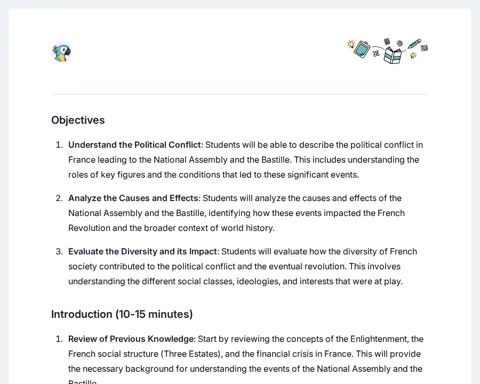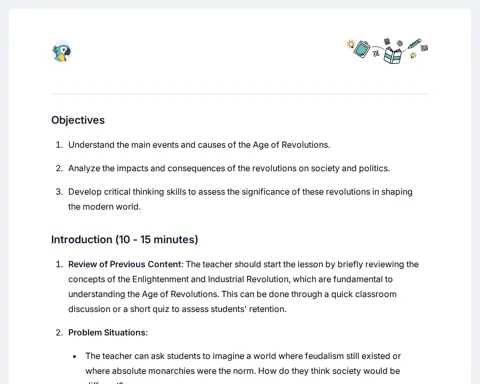Objectives
-
Introduction to Ancient Civilizations: Students should be able to understand the concept of an ancient civilization and identify the characteristics that define such a society.
-
Understanding Ancient Egypt: Students should develop a clear understanding of Ancient Egypt's culture, religion, art, and politics, and how these elements contributed to the formation of one of the most important civilizations in history.
-
Applying Knowledge: Finally, students should be able to apply the knowledge acquired about Ancient Egypt to answer questions, solve problems, and create their own interpretations of the studied historical period.
Introduction (10-15 minutes)
-
Review of Previous Content: Begin the lesson by briefly reviewing the concepts of civilization and its characteristics. This will provide a solid foundation for the introduction of Ancient Egypt.
-
Problem-Situation 1: The Pyramids of Giza: Show students an image of the Pyramids of Giza and ask them:
- "Who do you think built these pyramids and why?"
- "How do you think they were able to build such large and precise structures without modern technology?"
-
Problem-Situation 2: The Ancient Egyptian Mummy: Show students an image of an ancient Egyptian mummy and ask them:
- "Why do you think the ancient Egyptians preserved their dead in this way?"
- "What can this tell us about the ancient Egyptians' beliefs and understanding of the world?"
-
Contextualization: Explain to the students that Ancient Egypt was a civilization that flourished along the Nile River over 3,000 years ago. It is known for its pyramids, mummies, and rich culture, but there is much more to learn about this fascinating civilization.
-
Engage Students' Attention: To spark students' interest, share some fun facts about Ancient Egypt:
- "Did you know that ancient Egyptians used a calendar with 365 days, just like us today?"
- "Did you know that ancient Egyptians worshipped over 2,000 gods and goddesses?"
Development (20-25 minutes)
-
Group Research Activity: "The Egyptian Civilization" (10-15 minutes)
- Group Formation: Divide the class into groups of 4-5 students.
- Research Assignment: Each group will receive a different topic to research about Ancient Egypt. The topics may include: Pharaohs and Politics, Religion and Egyptian Mythology, Daily Life in Ancient Egypt, Art and Architecture, and the Nile River and Agriculture.
- Research: Students will use tablets or books to research their assigned topic. They should look for information on the importance of the topic for Ancient Egypt and how it influenced the civilization as a whole.
- Creation of Presentation: After conducting the research, students should create a brief presentation (3-5 minutes) to share their findings with the class. The presentation can be made using PowerPoint, Google Slides, or any other presentation tool available.
-
Group Activity: "The Egyptian Society" (10-15 minutes)
- Creation of Society Model: After the presentations, each group will receive modeling clay and other craft materials. They should use these materials to create a three-dimensional model of an Egyptian society, including the different social classes, temples, farms, pyramids, etc.
- Discussion and Construction: While building the model, students should discuss among themselves how the different aspects of Egyptian society connect and complement each other. The teacher should circulate around the room, assisting the groups when necessary.
- Presentation of the Model: At the end of the activity, each group should present their model to the class, explaining the different elements and how they relate to each other.
-
Discussion Activity: "The Legacy of Ancient Egypt" (5-10 minutes)
- Class Discussion: After all presentations, conduct a class discussion on the legacy of Ancient Egypt. Ask students how they believe the things they learned about Ancient Egypt can be applied in the present day.
- Teacher's Contribution: The teacher should provide examples of how Egyptian legacy is still present today, such as the use of a 365-day calendar, the practice of embalming, and the influence of Egyptian art and architecture on modern art and architecture.
Return (10-15 minutes)
-
Group Discussion (5-7 minutes)
- Sharing Experiences: Gather all students in a large circle and ask each group to share one interesting discovery they made during their research. This will allow students to learn from each other and see the diversity of aspects of Ancient Egypt that were covered.
- Connection to Theory: After each group's sharing, ask questions to ensure that students understand how their findings connect to the theory presented at the beginning of the lesson. For example, "How does studying Egyptian art help us understand their society and beliefs?"
-
Individual Reflection (3-5 minutes)
- Quiet Reflection: Ask students to take a minute to think about what they learned in the lesson. Then, ask the following questions and have them raise their hands to answer:
- "What did you find most interesting about Ancient Egypt?"
- "What questions do you still have about Ancient Egypt?"
- Teacher's Response: The teacher should listen carefully to students' responses, especially to questions that have not been answered. This will help guide future lessons and ensure that students' needs are met.
- Quiet Reflection: Ask students to take a minute to think about what they learned in the lesson. Then, ask the following questions and have them raise their hands to answer:
-
Lesson Feedback (2-3 minutes)
- Feedback Form: Hand out a feedback form for students to fill out. The form can include questions like: "What did you like most about today's lesson?" and "What could be improved for the next lesson?" Student feedback is a valuable tool for evaluating the effectiveness of the lesson and making adjustments for future lessons.
-
Closing the Lesson (1-2 minutes)
- Summary of the Lesson: Conclude the lesson by summarizing the main points discussed and reiterating the importance of Ancient Egypt for global history.
- Preparation for the Next Lesson: Briefly introduce the topic of the next lesson, if possible, connecting it to what was learned in today's lesson. For example, if the next lesson will be about the Roman Empire, you could say, "Just like Ancient Egypt, the Roman Empire was a powerful civilization with a rich and complex culture. In our next lesson, we will explore how the Romans lived, ruled, and built their impressive structures."
Conclusion (5-7 minutes)
-
Review and Recap (2-3 minutes)
- Summary of Key Points: Summarize the key points of the lesson, reinforcing the main aspects of Ancient Egypt that were addressed: its culture, religion, politics, art, and agriculture.
- Connection Between Theory and Practice: Highlight how the practical activities, such as group research and model creation, helped illustrate and deepen students' understanding of the theoretical concepts presented.
-
Extra Materials (1-2 minutes)
- Suggested Readings: Recommend books, articles, or websites for students who wish to learn more about Ancient Egypt. For instance, "The Egyptian Book of the Dead" is a fascinating primary source that explores ancient Egyptian beliefs and practices related to death and the afterlife.
- Documentaries and Movies: Suggest documentaries or movies that depict life in Ancient Egypt. "The Egyptian Book of the Dead" and "The Secrets of Ancient Egypt" are two examples that provide a visual and engaging way to learn more about the subject.
-
Everyday Application (1-2 minutes)
- Relevance of the Topic: Explain how the knowledge about Ancient Egypt can be applied in students' daily lives. For instance, understanding how the Egyptian calendar with 365 days was developed helps appreciate the importance of the calendar we use today.
- Critical Thinking: Emphasize that the ability to analyze and interpret information about Ancient Egypt helps develop important skills such as critical thinking and problem-solving, which are applicable in various areas of life.
-
Lesson Closure (1 minute)
- Thank You and Farewell: Thank the students for their participation and effort during the lesson, and encourage them to continue learning and exploring the fascinating world of Ancient Egypt.




